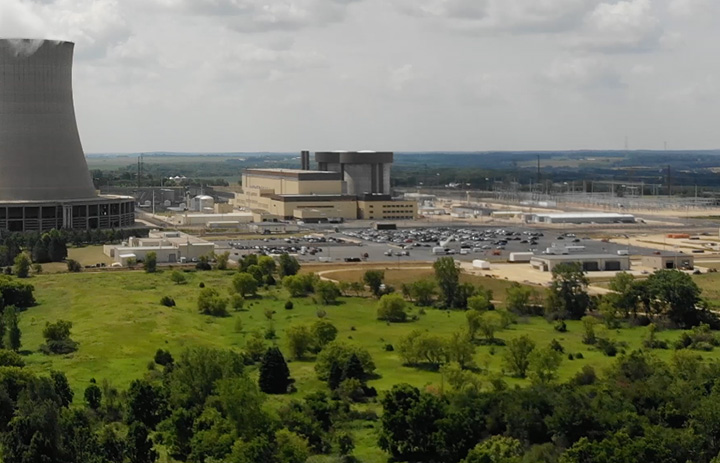Webinar summary: The role of nuclear in Illinois

The University of Illinois Student Section and Chicago Local Section of the American Nuclear Society hosted a webinar, The Role of Nuclear Power in Illinois, on Wednesday, March 31. The webinar provided information for state lawmakers and the general public about the potential consequences of closing the Byron and Dresden Generating Stations, two of the nuclear power plants in the state of Illinois.
The webinar recording has been archived and is available for viewing for free at the above link.
Byron and Dresden: The speakers discussed how the premature closure of the plants will affect carbon emissions, efforts to reach state climate goals, and local economies and tax revenue. Speakers included representatives from ANS, the Nuclear Energy Institute (NEI), the Byron Station Response Committee, the International Brotherhood of Electrical Workers, and more.
Information available on the webinar's home page includes economic impact analyses of the closings of Byron and Dresden, a review of the Climate Union Jobs Act (CUJA) recently introduced in the Illinois legislature, and the speakers' bios, in addition to the webinar recording.
Exelon Corporation announced premature closure of Byron and Dresden—in September and November 2021, respectively—unless legislation were passed to help make the plants more profitable in the current energy market. The decision to close the plants is based on the lack of profitability amid falling energy prices and stagnant energy demand. Both of these plants are members of the PJM energy market. The current operating license for Byron will not expire until 2044, and the current operating license for Dresden will not expire until 2029. A final decision will be made in May or June 2021 on the fate of the plants.
During the webinar, the speakers identified multiple benefits provided by the nuclear plants, including their strong, reliable performance, the carbon-free energy they generate, and the economic impacts they have on their local areas. The panelists also discussed the new bill—CUJA—that could save the plants from premature closure.

Rezin

Blomquist
Reliable power generation: One of the largest strengths of nuclear power plants is their ability to operate 24-7 with very high capacity factors, independent of the weather. Roger Blomquist, a retired nuclear engineer, said that since 2000 the nuclear plants in the United States have averaged a capacity factor greater than 90 percent, with an average of more than 92 percent in the past five years. This is due largely to the energy density of the uranium fuel, which allows the reactors to operate for 18 to 24 months between refueling. Nuclear power plants are able to operate in almost any weather condition, such as the polar vortex of 2014. Sen. Sue Rezin, 38th District for the Illinois Senate and deputy minority leader, spoke about how the nuclear plants in her district were able to continue operating and producing power during the 2014 polar event, while some of the chemical plants in the district had to close down for a few days due to a lack of power from natural gas plants.

Glidic
Jimmy Glidic, IBEW Local #15 Electric Union steward at Dresden, identified one reason the nuclear power plants are so reliable: plant components are not run to failure and are replaced long before they would fail. Power plants are also continuously investing in training for their workers to ensure they are prepared for any occurrence at the plant and are competitive in the workforce. An example of this, provided by Blomquist, is that each plant has a simulator room for each of the reactors to provide operator training on regular and unlikely events. Because of the high maintenance investment in the plants and their workers, nuclear power plants are able to operate for a long time. Blomquist spoke to these long lifetimes, identifying that original licenses for nuclear power plants were 40 years (a figure picked for conservatism): 91 licenses have been renewed to allow those plants to run for 60 years, and two second license renewals have been completed to allow those plants to run for 80 years. There is even some research to suggest the plants could operate for 100 years.

Kotek
Carbon emissions and state climate goals: Another large impact of the Illinois nuclear plants is their production of carbon-free energy. The six nuclear plants in Illinois produce about 54 percent of the energy in the state and almost 90 percent of the state’s clean energy, with a total capacity of 11.6 GW. The power produced from Byron and Dresden alone totals to more power than the production of all 7,200 wind turbines in California, as pointed out by John Kotek, vice president for policy development and public affairs at NEI. The contributions from the nuclear plants result in the equivalent of avoiding emissions from 13 million cars and allow for about two-thirds of the state’s energy generation to be clean.
Illinois governor J. B. Pritzker has established a desire to have a 100-percent clean energy portfolio in the state by 2050. The state’s nuclear plants are a significant contribution to reaching this goal, and Rezin argued that there is no meaningful way to reach this goal without nuclear plants.

Dunzik-Gougar

Bugg
If the plants were to close, the energy they produce would need to be replaced by another generation source. Kent Bugg, superintendent for Coal City School District #1, discussed how, if the generation were to be completely replaced by renewables and because of differences in capacity factor, a much larger installed capacity of renewables would be required to match nuclear’s output. Nuclear power operates with a greater than 90 percent capacity factor, while solar and wind operate with 25 percent and 35 percent capacity factors, respectively. This means that to replace 1 GW of power produced from a nuclear plant, a 4 GW of installed solar power would be needed, approximately. As ANS president Mary Lou Dunzik-Gougar identified, however, in previous closings of nuclear plants in other states, the majority of power generation was replaced by fossil fuel sources, mostly natural gas. When the Vermont Yankee nuclear plant closed in 2014, the state of Vermont saw a 13 percent increase in natural gas use and a subsequent 16 percent increase in carbon emissions. Dunzik-Gougar also identified that no state that has experienced a nuclear plant closure has been able to return their emissions to the levels they were at prior to the closing: the emissions have stayed at elevated levels.
Local economy support: Nuclear power plants make a large contribution to their local economies through taxes, numerous jobs, and high salaries. The Byron plant accounts for 15 percent of the annual GDP of Ogle County, while Dresden accounts for 11.5 percent of the annual GDP of Grundy County.
The taxes paid by the plants each year are significant funding sources for local groups, including fire departments, park districts, and school districts. In the tri-county area around Byron, these local groups receive nearly $35 million in taxes each year, contributing up to 91 percent of each group’s annual revenue. For comparison, the largest wind farm (Twin Groves) in the state of Illinois paid $34 million in property taxes between more than a decade spanning 2008 to 2019. Funding from Byron helps to support the Byron #226 School District, which has about 13,500 students and has received national recognition for its schools and special education programs. Coal City School District receives about 60 percent of its $30 million budget from the Dresden plant.

Lynde
While other school districts in the state are able to perform well without revenue from nuclear plants, the sudden closure of the plants would lead to sudden, drastic changes to account for the lost revenue. This includes significant program cuts, shifting some of the revenue burden to local taxpayers, as Bugg identified, or securing more funding from the state, as discussed by Christine Lynde, president of the Byron Board of Education. The short-notice closure of the plants does not provide enough time for school districts to adequately plan for the lost revenue. For example, if a school district requests more funding from the state, then because the state’s evidence-based funding formula uses old data, it would take a few years to catch up on the current (new) needs of the district.

Piercy

Downs
Nuclear power plants also supply hundreds of well-paying jobs to the local community. In Grundy County, Dresden supports 804 direct jobs at the plant, which account for $104 million in annual payroll. Byron directly and indirectly supports 2,305 jobs in the tri-county area, with a job multiplier of 3.21, as explained by Sarah Downs, executive director of the Bryon Chamber of Commerce. In total, the nuclear plants in the state contribute about $400 million annually to their regional economies. Bugg shared an example of this support told to him by a local restaurant owner: the outages at Dresden account for 20 percent of the restaurant’s business each year, even though outages are typically less than a month. ANS chief executive officer Craig Piercy spoke to how the clean energy provided by these plants is identified as a competitive advantage to attract more business to the state, as more companies are pledging to decarbonize their operations and their supply chains. Having additional businesses in the state only further strengthens the state economy.

Balla
The University of Illinois at Urbana-Champaign (UIUC) has one of the most highly ranked nuclear engineering programs in the country. Anna Balla, UIUC undergraduate student in nuclear, plasma, and radiological engineering, spoke about how the closure of Byron and Dresden would not only reduce the number of opportunities for young graduates in Illinois, but it also would send a message to these young people that nuclear is not a priority for the state. The closure of Dresden and Byron would lead to students and workers employed at the plants to leave the state to look for work, contributing to a “brain drain” in the state regarding this area of expertise.
Possible solutions: The panelists held a brief discussion about a possible solution to keep the plants open. Rezin discussed a recently filed CUJA bill in the state legislature. This bill, authored by Climate Jobs Illinois, includes language to increase union membership for clean energy production and creates just transition for communities reliant on fossil fuels, invests $50 million in job training, includes $150 million in rate relief for families, and preserves the state’s nuclear fleet. It is intended to be a bridge until something is done on the federal level to value the contributions that nuclear power brings to communities and the United States. Bugg emphasized that this bill is a great opportunity to help save Byron and Dresden since it values nuclear as a clean energy producer.
Amanda Bachman, Anna Balla, and Jimmy Shehee are ANS student members and attend the University of Illinois at Urbana-Champaign.








